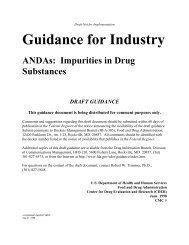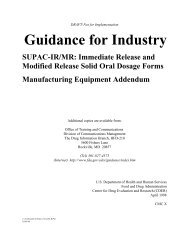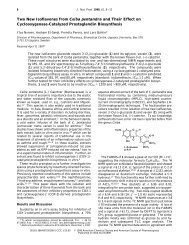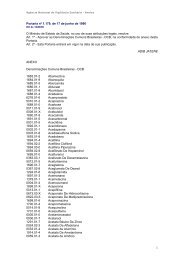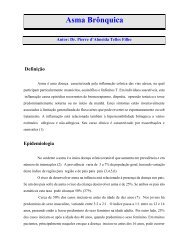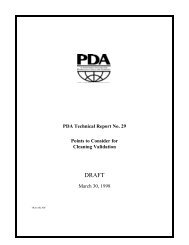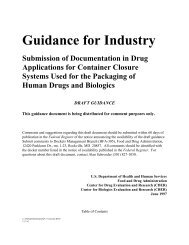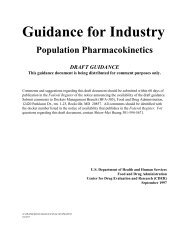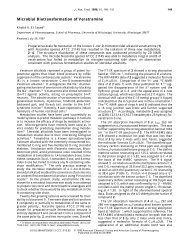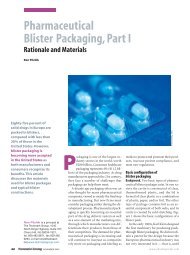Bioanalytical Methods Validation for Human Studies - Pharmanet
Bioanalytical Methods Validation for Human Studies - Pharmanet
Bioanalytical Methods Validation for Human Studies - Pharmanet
Create successful ePaper yourself
Turn your PDF publications into a flip-book with our unique Google optimized e-Paper software.
Draft — Not <strong>for</strong> Implementation<br />
To obtain within-batch data, the mean, standard deviation, and CV of each QC<br />
concentration in each batch should be calculated. The global (overall) mean, standard<br />
deviation, and CV <strong>for</strong> each QC concentration from the three batches should be calculated<br />
to obtain between-batch data. Precision is indicated by the %CVs. Percent accuracy is<br />
determined by dividing the mean concentration of a QC by its nominal concentration, and<br />
multiplying by 100.<br />
E. Stability<br />
Drug stability in a biological fluid is a function of the storage conditions, the chemical<br />
properties of the drug, the matrix, and the container system. The stability of an analyte in<br />
a particular matrix and container system is relevant only to that matrix and container<br />
system and should not be extrapolated to other matrices and container systems. Stability<br />
procedures should evaluate the stability of the analytes in biological fluids after long-term<br />
(frozen at the intended storage temperature and conditions) and short- term (bench top,<br />
room temperature and conditions) storage, and after going through freeze and thaw cycles<br />
and the analytical process. The procedure should also include an evaluation of analyte<br />
stability in stock solution (Buick 1985, Pachla 1989).<br />
All stability determinations should use a set of standard samples prepared from a freshly<br />
made stock solution of the analyte in the appropriate analyte-free, interference-free<br />
biological matrix. Stock solutions of the analyte <strong>for</strong> stability evaluation should be<br />
prepared in an appropriate solvent at concentrations defined in the method SOP. Further<br />
in<strong>for</strong>mation about validation <strong>for</strong> these factors appears in the following five sections of the<br />
guidance.<br />
1. Freeze and Thaw Stability<br />
Testing <strong>for</strong> freeze and thaw analyte stability should be determined during three<br />
freeze and thaw cycles. At least three aliquots at each of the low and high<br />
0<br />
concentrations should be stored at -20 C, or the intended storage temperature, <strong>for</strong><br />
24 hours and thawed unassisted at room temperature. When completely thawed,<br />
the samples should be transferred back to the original freezer and kept refrozen <strong>for</strong><br />
12 to 24 hours. The cycle of thawing and freezing should be repeated two more<br />
0<br />
times, then analyzed on the third cycle. If an analyte is unstable at -20 C, the<br />
0<br />
stability sample should be frozen at -70 C during the three freeze and thaw cycles<br />
(Shah 1992, Buick 1990).<br />
2. Short-Term Room Temperature Stability<br />
j:\!guidance\2578dft.wpd<br />
12/14/98 7



